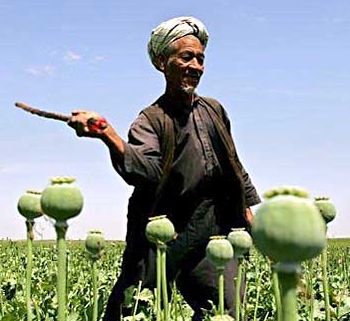
"AFGHANISTAN CLAIMS TITLE OF WORLD'S LARGEST HEROIN PRODUCER" reports the 24-7PressRelease- OAK RIDGE, NJ, April 06, 2008 — As 18,000 American troops continue to fight terrorism in Afghanistan, a new threat to global security rears its ugly head: the country's growing drug trade.
"Afghanistan has become the world's largest exporter of heroin," says Stephen Della Valle, author of the new addiction and recovery memoir Rising Above the Influence. "Nearly sixty percent of their gross national product comes from sales of the drug, which may also be funding the country's reconstruction—even more so than any foreign aid they're being given."
Fields of opium poppies have long grown in almost every province of Afghanistan, but only in the last twenty-five years have they developed into the country's biggest cash crop. Last year, Afghan "farmers" cultivated a half million acres and produced 4,000 tons of opium, much of which was made into 400 tons of morphine and heroin.
"Ninety-two percent of the world's heroin comes from Afghanistan these days," notes Mr. Della Valle. "They produce more heroin than Colombia produces cocaine, and that's really saying something."
While the people of Afghanistan are making $3 billion a year from their sales of the drug, the addicts themselves are suffering from some of heroin's most deadly side effects, including: Collapsed veins, Infection of the heart lining and valves, Liver disease, Pneumonia, Increased risk of contracting HIV, hepatitis C and other infectious diseases.
"With the overthrow of the Taliban," says Mr. Della Valle, "Afghanistan's political and economic situation surely improved. But the US' vow to end drug production in that country has so far come to nothing. The country's role in the worldwide addiction epidemic remains as serious as ever." (source: 24/7)
The United Nations News Centre reported on 29 July 2011 – The head of the United Nations anti-drugs agency has called for strengthening border controls around Afghanistan – still the world’s leading producer of opium and heroin – boosting security in that country, and lowering demand in so-called “consumer countries.”
Yury Fedotov, Executive Director of the UN Office on Drugs and Crime (UNODC), said in an introduction to a new study, Global Afghan Opium Trade – A Threat Assessment, that curtailing the Afghan illegal drug trade would “benefit the Afghan people, the wider region and the international community as a whole.”
“Trafficking in Afghan opiates is… very lucrative, generating some $61 billion in illicit funds in 2009 out of $68 billion for the global illicit opiate trade,” according to the report.
“Most of this money went into the pockets of traffickers all along the transnational heroin distribution routes, and some went to insurgents.” Afghan farmers earn relatively little from the trade, the report noted.
Spanning a decade, the report states that some 16.5 million people annually abuse opiates worldwide. Heroin takes the bulk of the market, with 12 million to 13 million people consuming 375 tons of heroin per year; of that, 150 tons are consumed in Europe.
Afghanistan is the world's largest producer of opium; while poppy cultivation was relatively stable at 119,000 hectares in 2010, a poppy blight affecting the high cultivation areas in 2010 reduced potential opium production to 3,200 metric tons, down over 40 percent from 2009; the Taliban and other anti-government groups participate in and profit from the opiate trade, which is a key source of revenue for the Taliban inside Afghanistan; widespread corruption and instability impede counterdrug efforts; most of the heroin consumed in Europe and Eurasia is derived from Afghan opium; vulnerable to drug money laundering through informal financial networks; regional source of hashish (2011) . (source: CIA)
In 2007, Afghanistan supplied 93% of the world's opium, according to the U.S. State Department. Illicit poppy production, meanwhile, brings $4 billion into Afghanistan,[12] or more than half the country’s total economy of $7.5 billion, according to the United Nations Office of Drug Control (UNODC).[13] It also represents about half of the economy of Pakistan, and of the ISI in particular.[source: Global Research]
Opium poppy cultivation and drug trafficking have become significant factors in Afghanistan’s fragile political and economic order over the last 25 years. Since the fall of the Taliban in late 2001, Afghanistan has become the source of 87% of the world’s illicit opium and heroin, in spite of ongoing efforts by the Afghan government, the United States, and their international partners to combat poppy cultivation and drug trafficking. Across Afghanistan, regional warlords, criminal organizations, and corrupt government officials continue to exploit opium production and trafficking as reliable sources of revenue and patronage, which perpetuates the threat these groups pose to the country’s fragile internal security and the legitimacy of its embryonic democratic government. The trafficking of Afghan drugs also appears to provide financial and logistical support to a range of extremist groups operating in and around Afghanistan, including remnants of the Taliban regime and Al Qaeda operatives. U.N. officials estimate that in-country illicit profits from Afghanistan’s record 2004 opium poppy crop were equivalent in value to 60% of the country’s legitimate GDP. (source: 2004 CRS Report to Congress)




This is enlightening information, and all the more reason to get the message out that recovery from heroin addiction is possible. Buprenorphine treatment has been proven effective in helping recovery to be long-term.
ReplyDelete